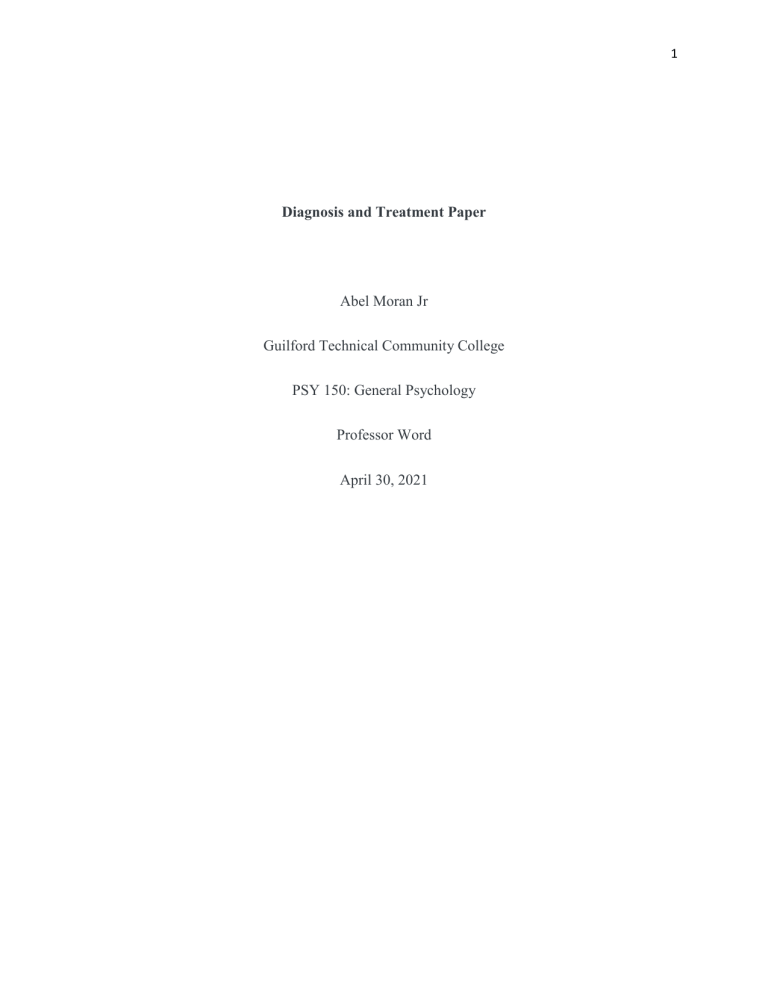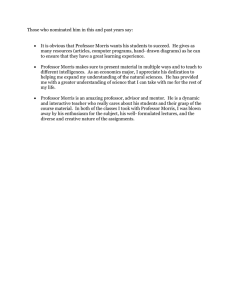
1 Diagnosis and Treatment Paper Abel Moran Jr Guilford Technical Community College PSY 150: General Psychology Professor Word April 30, 2021 2 Case Study #1 Specific Phobia is defined in Psychology in Your Life as “A fear of a specific object or situation that is disproportionate to the threat (Grison and Gazzaniga, 2019, Pg 556)” or in other words means she has an irrational fear to something. An example of this would be claustrophobia or a fear of being in confined spaces such as an elevator or a tunnel. Specific Phobia can cause symptoms such as severe anxiety, increased heart rate. This form of Psychological Disorder can be related to our first case. The first case within this case study is with Hannah. Hannah, age 55, was in a major car accident 20 years ago during a cross country trip. Ever since, she has been unable to drive on major highways. Although she does drive, she goes to great lengths to travel only on back roads and scenic routes. She can go where she wants but it often takes her much longer to get there than it should. Hannah could be experiencing an extended form of Specific Phobia. In the case, Hannah talks how she has been unable to travel on major highways and how she goes great lengths to get where she needs to go. She is willing to spend extra money and time to get away from an irrational fear help proves that it is case of specific phobia. This specific phobia of highways is sometimes called Autokinetodromophobia. Autokinetodromophobia means to have a fear of highways and will find ways to avoid the situation which perfectly describes the situation Hannah is in. Two major ways of Treatment for Specific Phobia is Exposure Treatment and Systematic Desensitization. Exposure treatment is a “Therapy technique that involves repeatedly exposing a client to an anxiety-producing stimulus or situation and has the goal of reducing the client’s fear (Grison and Gazzaniga, 2019, Ch 14)”. Systematic Desensitization is a “Therapy technique that 3 involves exposing a client to increasingly anxiety-producing stimuli or situations while having the client relax at the same time (Grison and Gazzaniga, 2019, Ch 14)”. The course of treatment for Hannah would be slowly reintroducing her to highway or driving as if she were new at driving. This disorder can be overcoming in a few steps. First, having Hannah be in the passenger seat while another drive starts driving across highways or busy streets and slowly working towards short distances on highway. Once Hannah becomes used to being a passenger in a vehicle driving on a highway, it would be time to introduce her driving onto highways. Once again, it would start with driving across busy streets and small highways. Once she can manage driving on smaller highways, doing small runs on a highway. Soon she will be able to slowly drive longer distances on a highway until her specific phobia has been cured. In her specific case, it may take longer than usually because of the amount of time she has had this phobia. Having a habit over longer time makes it harder to break. Case Study #2 Major depressive disorder or depression is “Mood disorder, characterized by extremely depressed moods or a loss of interest in normally pleasurable activities, that persists for two weeks or more. (Grison and Gazzaniga, 2019, Pg 562)”. This differs from Persistent depressive disorder because it typically lasts a short period but is more severe. Symptoms include lack of interest is pleasurable activities, this can also lead to lack of sleep and changes in weight. Thoughts of self-harm or suicide is also severe symptoms of Major depressive disorder. The second case is Morris has been referred to you for psychotherapy following a suicide attempt. When you interview him, he is very teary, He speaks slowly and looks down at the ground as he speaks. He reports difficulty in falling asleep and staying asleep for the past month. Morris states that he hasn't had much of an appetite and has lost 15 pounds. He reports that 4 things he used to like just don't seem enjoyable anymore, and he thinks that life is not worth living. Morris doesn't expect things to improve in the future, which is why he tried to kill himself. Morris claims to have issues sleeping, losing weight, and being motivated. He also has trouble being motivated. The issues have been having are very similar to symptoms related to Major depressive disorder. Talking slowly and not making eye contact could also be signs of depression. His suicide attempt also proves that he believes nothing will get better, also signs of depression. There is a chance that the environment he has put himself in is causes himself to look lower upon himself giving him low self-confidence. Depression has many ways to cure, and many different steps could help cure depression. If Morris has been a bad environment with people, it might be beneficial for Morris to find better and more supportive friends. If Morris is having trouble with a family situation or a problem, giving him support or offering to give advice. There are many different prescribing antidepressants may help him have more control over his emotions and allow to feel happier until his emotional state becomes more stable. There are many different types of depression medicine and there can be many different types of cures but letting Morris understand the full consequences of suicide may help him try to get better. They could take the medicine and after some time of showing improvements be slowly taken away to find an independent happiness. Over time Morris’s Major depressive disorder will slowly disappear over time and the symptoms will die down. He will eventually become able to function without needing medicine and will be able to be motivated. He will become emotionally stable and become happy. 5 Works Cited Grison, S., & Gazzaniga, M. S. (2019). Psychology in your life. W.W. Norton & Company. Maskey, M., Rodgers, J., Grahame, V., Glod, M., Honey, E., Kinnear, J., Labus, M., Milne, J., Minos, D., McConachie, H., & Parr, J. R. (2019). A Randomised Controlled Feasibility Trial of Immersive Virtual Reality Treatment with Cognitive Behaviour Therapy for Specific Phobias in Young People with Autism Spectrum Disorder. Journal of Autism and Developmental Disorders, 49(5), 1912–1927. Valdes, F., Keary, C. J., Mullett, J. E., Palumbo, M. L., Waxler, J. L., Pober, B. R., & McDougle, C. J. (2018). Brief Report: Major Depressive Disorder with Psychotic Features in Williams Syndrome--A Case Series. Journal of Autism and Developmental Disorders, 48(3), 947–952. 6




